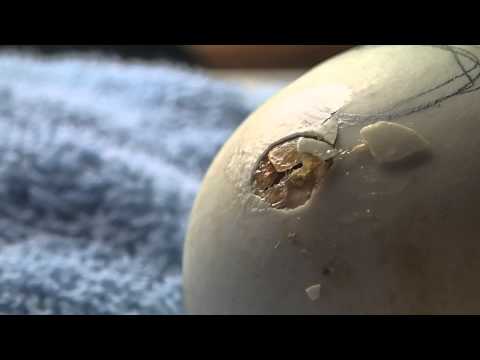- Aug 29, 2013
- 47
- 3
- 24
History:
Runner Duck Eggs, First Time hatching (of course)
Placed in Homemade Cooler incubator on Feb 13th in the evening.
Fan, water tub with sponge and light bulb set up, eggs laying on sides. Wasn't a good hand turner in the beginning, but got much better schedule as we went.
Temp has been 99-100 Humidity was 40-50% and then bumped up to 55-70% last two days.
Noticed air cell shadows of beaks on Sunday the 9th.
Yesterday was lock down day, but before that had internal pips on a few eggs with internal cheeping.
This evening around 7 pm noticed a cracked/pip like area on an egg that is very below the air cell.
I took out egg to candle and see the shell hole closer.
Duckling is alive and cheeping and shows internal pip shadow in the air cell- away from the hole in the shell.
Open hole looked dry and very yellow. Per this threads pics, I thought they were dry, so I applied triple antibiotic (not with painkiller) and placed the egg back in incubator on a damp paper towel.
Now, 4.5 hours later, still cheeping inside, triple antibiotic oint appears to have soaked in or dried up a bunch, but still got a thin layer.
I know they aren't due until tomorrow or the next, but was concerned about the odd crack in the shell so very below the air cell.
Note the yellow/yolky colored membrane (?)

You can see the air cell lines above the S (which meant I could see a pipping shadow the other day)

Side view to show how far from air cell.

Thoughts?? Just leave alone as long as he is cheeping in there?
Runner Duck Eggs, First Time hatching (of course)
Placed in Homemade Cooler incubator on Feb 13th in the evening.
Fan, water tub with sponge and light bulb set up, eggs laying on sides. Wasn't a good hand turner in the beginning, but got much better schedule as we went.
Temp has been 99-100 Humidity was 40-50% and then bumped up to 55-70% last two days.
Noticed air cell shadows of beaks on Sunday the 9th.
Yesterday was lock down day, but before that had internal pips on a few eggs with internal cheeping.
This evening around 7 pm noticed a cracked/pip like area on an egg that is very below the air cell.
I took out egg to candle and see the shell hole closer.
Duckling is alive and cheeping and shows internal pip shadow in the air cell- away from the hole in the shell.
Open hole looked dry and very yellow. Per this threads pics, I thought they were dry, so I applied triple antibiotic (not with painkiller) and placed the egg back in incubator on a damp paper towel.
Now, 4.5 hours later, still cheeping inside, triple antibiotic oint appears to have soaked in or dried up a bunch, but still got a thin layer.
I know they aren't due until tomorrow or the next, but was concerned about the odd crack in the shell so very below the air cell.
Note the yellow/yolky colored membrane (?)
You can see the air cell lines above the S (which meant I could see a pipping shadow the other day)
Side view to show how far from air cell.
Thoughts?? Just leave alone as long as he is cheeping in there?



